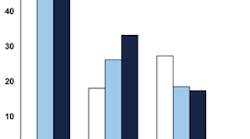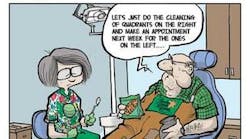Risky business: Managing patients with active herpes labialis in the dental setting
Encountering patients with active cold sores presents unique challenges for dental professionals. While the primary concern is preventing transmission, additional factors like patient safety, legal implications, and ethical considerations must also be carefully navigated.
Transmission routes and patient risks
Herpes simplex type 1 (HSV-1), the virus responsible for cold sores, is highly contagious. Transmission can occur directly with infected lesions, contaminated instruments, or airborne droplets from sneezing or coughing.1 Dental procedures involving close contact with the oral cavity and potential exposure to saliva heighten the risk of transmission to patients and dental professionals.
If a patient acquires HSV-1 during their dental appointment, the consequences can vary; for example, those experiencing a primary infection can experience a more severe initial infection with fever, malaise, and widespread oral lesions. For those with existing HSV-1, exposure can trigger another outbreak, potentially exacerbating existing oral health concerns. Moreover, HSV-1 infections can lead to severe complications in people with weakened immune systems.
Ethical dilemmas and legal considerations
Seeing patients with active cold sores involves ethical and legal complexities. While the American Academy of Oral Medicine recommends delaying care for infection control, it emphasizes balancing a patient's dental needs with transmission risks. If deemed necessary, managing patients with active herpes labialis lesions requires stringent safety measures2 requiring these careful considerations.
- Reschedule nonurgent appointments: Postpone elective procedures until the lesions heal completely.
- Open communication: Explain the transmission risks to the patient and seek informed consent.
- Enhanced infection control: Implement meticulous hand hygiene, wear appropriate PPE like masks and gloves, and thoroughly disinfect instruments and surfaces.
- Minimize aerosol-generating procedures: Avoid ultrasonic scaling or high-speed drilling that could aerosolize the virus. Consider antiviral therapy: In some instances, short-term antiviral medication for the patient might be warranted to reduce viral shedding.
What if it’s not the patient, but one of us?
Dental professionals with active cold sores are generally advised to avoid treating patients, especially for nonemergency procedures.3,4 The Occupational Safety and Health Administration (OSHA) guidelines and published literature highlight the importance of minimizing transmission risk, ensuring patient comfort and safety while allowing the professional to focus on recovery.
As Harrel and Molinari suggest, practitioners should assume that all patients have infectious diseases potentially spread by aerosol.5 This concept should be included in the profession's understanding of universal precautions. While PPE eliminates much of the danger from spatter or large particles, aerosols still have the potential to be inhaled via leaks in the mask and to travel around safety glasses. They suggest a layered approach to protection, including high-volume evacuators—which can capture up to 95% of aerosols—safety glasses with side shields, and goggles.
When all our safety measures fail: herpetic whitlow
Compared to other professions, dental professionals are at higher risk for developing herpetic whitlow, an HSV-1 infection characterized by painful, swollen fingers with blisters and a tingling or burning sensation. We should prevent infection by following strict hygiene, using PPE, avoiding contact with active cold sore lesions (if possible), and wearing gloves while performing dental procedures.5-7
Active herpes labialis in a dental setting signifies a delicate balance between patient needs and risk mitigation. We must be well-versed in the potential transmission risks, understand the ethical and legal implications, and implement meticulous infection control practices to ensure our and our patients’ safety. Open communication, informed consent, and a patient-centered approach remain crucial in navigating this delicate situation effectively.
References
- Zhu S, Viejo-Borbolla A. Pathogenesis and virulence of herpes simplex virus. Virulence. 2021;12(1):2670-2702. doi:10.1080/21505594.2021.1982373
- Browning WD, McCarthy JP. A case series: herpes simplex virus as an occupational hazard. J Esthet Restor Dent. 2012;24(1):61-66.
- US Occupational Safety and Health Agency. (Final Rule); Occupational and Safety Health Standards. United States Code of Federal Regulations; see 29 CFR 1910.1030
- Lewis MA. Herpes simplex virus: an occupational hazard in dentistry. Int Dent J. 2004;54(2):103-111. doi:10.1111/j.1875-595x.2004.tb00263.x
- Harrel SK, Molinari J. Aerosols and splatter in dentistry: a brief review of the literature and infection control implications. J Am Dent Assoc. 2004;135(4):429-437. doi:10.14219/jada.archive.2004.0207
- Betz D, Fane K. Herpetic Whitlow. July 31, 2023. Treasure Island: StatPearls Publishing. PMID: 29494001.
- Shoji K, Saitoh A. Herpetic Whitlow. N Engl J Med. 2018;378(6):563. doi:10.1056/NEJMicm1711479
Andreina Sucre, MSc, RDH, is an oral pathology and oral surgery specialist, and a practicing dental hygienist in South Florida. She’s a speaker, writer, and advocate for early pathological diagnosis. Andreina was born in Venezuela where she earned her dental degree in 2002 from Universidad Santa Maria. In December 2005, she earned her certificate and specialization degree in oral pathology and oral surgery from Pontificia Universidad Javeriana, in Colombia. Follow her on Instagram @ThePathoRDH.









